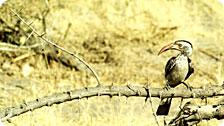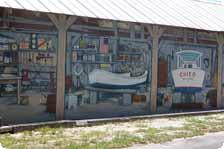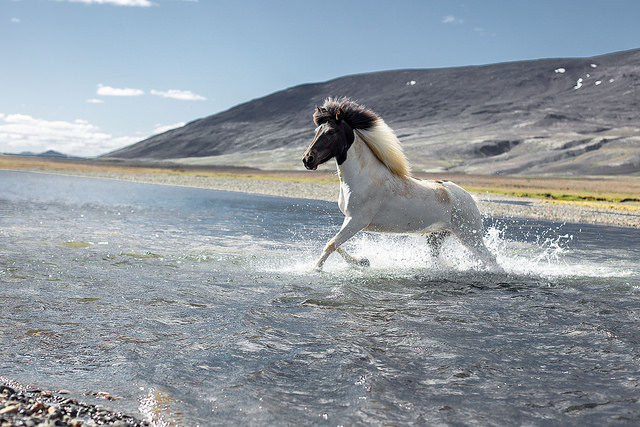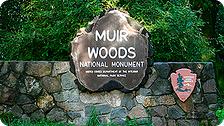by Sharon Dewar
The army of elephants stood stiffly, alert and imposing, their powerful
gray silhouettes staring intensely at our open-aired Land Cruiser. It was
our second night on safari, and the sky was dark and foreboding as we
drove alongside Botswana’s Khwai River, a tributary that feeds into the
Okavango Delta, on the northern border of the Moremi Game Reserve.
Hundreds of elephants filled the river, with endless herds arriving like
phantoms mutely making their way from the brush to the water. I sat
silently, wrapped in darkness with three other safari-goers and our guide,
parked on the riverbed quietly observing the herds. The calm and
tranquility was abruptly shattered when another vehicle careened down the
dusty road toward us, obviously in a hurry and with little interest in
watching elephants nor concern for startling them.
Our guide, Dave Carson, sensing the animals’ surprise and tension,
remained calm, but on high alert. “Are you ready for a show?” he said as I
held my breath, not knowing what to expect. The elephants panicked and
tore through the water, trunks in the air trumpeting and screaming. Nearly
thirty enormous animals stampeded toward us looking like a wall of doom
and sounding like a rushing waterfall.
My heart raced; I couldn’t breathe. Mere feet from a mass collision of flesh on metal, the tirade of elephants
veered to the left running behind our vehicle and disappearing into the
bush. I heaved a hot breath, sighs of relief were heard all around.
Adrenaline coursed through my veins, and I realized then that African
safaris are not for the faint of heart. Little did I know that this would
be the first of many heart-racing adventures ahead.
It was my first trip to Africa, a land of dreams and Discovery Channel
shows. Rugged and untamed. I wanted to witness one of Earth’s last wild
strongholds—a feral frontier—before it’s gone. Botswana, I was told,
is the place to do just that: a land teeming with wildlife but few
tourists.
I escaped on the great-getaway during September, one of the best
times to visit the area. The southern hemisphere winter is nearing its
end, and it’s the dry season, meaning the remaining water sources are sure
to be abundant with wildlife.
The adventure began at a small airport in Maun, Botswana where we met our
safari guides Nic Polenakis and Dave Carson, two lively and personable
Zimbabwe natives. Six Californians and one Nebraskan farmer made up our
diverse tour group, ranging from 30 to 64 years old.
We boarded two Land
Cruisers and departed on a rugged five-hour journey to Moghoto Camp, a
private campsite near Moremi Game Reserve arranged through the eco-tour
company, Capture Africa (www.captureafrica.co.za), who specializes in photographic safaris.
As we journeyed through barren desert toward one of the Okavango Delta’s
wet outstretched fingers, the landscape transformed from lifeless
desolation to wildlife haven. I watched mesmerized as the first wild
elephant I would ever encounter, a monstrous, confident bull sauntered
across the dirt road mere feet away.
He strutted slowly, with uncanny
silence. His enormous gray feet kissing the earth without a whisper.
The smells of spicy sage and wild basil wafted through the dry air. Regal
giraffes stretched long necks browsing on acacia trees lush with yellow,
fragrant blossoms. Impala gracefully leapt through golden grasses
alongside grazing zebra and waterbuck.
Within the marshy reeds and lilies
of the waterway hippopotamus bubbled. Eyes peeked out, slow, curious,
intense. Purplish gray nostrils breached, snorted, then submerged,
disappearing under a glassy surface.
Sleeping roadside, three large tawny figures took shape amongst the ocher
grasses: lion! A large commanding male shot up and stared at us with
daunting yellow eyes. We were in awe. He was not, however, and quickly
fell back down with a thump and went to sleep.
Not far from the lions, our campsite was tucked into a cozy grove of
acacia trees. A cheerful staff greeted us with dinner by candlelight. To
my surprise it wasn’t typical campfire fare like baked beans and hotdogs;
instead we were treated to butternut squash soup, quiche, fresh baked
bread, vegetables and wine.
My tent was as delightful and extravagant as
the meal—a roomy Meru-style tent adorned with thick, comfortable beds,
a hurricane lantern and nightstand. Most surprising, and certainly a bit
of a relief, was its attached primitive bathroom and shower. After seeing
those lions, the idea of leaving the tent for a midnight visit to the
latrine wasn’t appealing.
Despite the comfy beds, sleep was nearly impossible as I lay awake,
reeling with excitement, listening to the foreign and fascinating sounds
of the night. Deep guttural moans from lions in the distance, the choruses
of painted reed frogs like a symphony of bamboo wind chimes, the nearby
whooping of hyena.
Hippos were comical with rowdy honks, groans and
snorts, like hundreds of whoopee cushions. With the morning came a whole
new world of music from the birds chattering to the drone of thousands of
bees in the treetops.
Each morning began at 5 a.m. with a hasty breakfast, then a game drive at
sunrise to capture wildlife images by the golden glow of early light. The
hot, dry afternoons easily lent themselves to siestas until the air cooled
enough for a late-afternoon game drive.
Each evening culminated with a
night game drive. Using a spotlight, we’d seek out nocturnal critters
lurking in the darkness from busybody springhares and porcupine to
beautiful and elusive leopards. Night drives, off-roading and walking
safaris are not allowed in the National Parks and Game Reserves but are
permitted on privately managed reserves such as the Khwai Development
Trust that borders Moremi Reserve.
Both day and night, elephants were everywhere. They seemed to linger
around every bend and be hiding behind every bush. Botswana boasts the
largest population of pachyderms in Africa, currently estimated at 120,000.
Large swaths of trees and brush in many areas are stripped and savaged by
the enormous eating machines, leaving only skeletal remains of forests.
Botswana, like many Southern African nations, is struggling with how to
manage the ever-growing elephant population.
No matter how common, the awe of the elephant’s majestic presence never
fully wanes, especially when you stalk one on foot. Nic Polenakis turned
out to be an exceptional tracker, studying prints in the sand like a
forensic detective at a crime scene, determining the animal’s age, gender
and how far away the animal is simply by looking at a footprint. He seemed
to read the wind, and understand every sound as if the land was talking
only to him.
He knew exactly what the elephants were doing, how close we
were to them, and if they knew we were coming. Amazingly, his estimations
were spot-on. As we came to a clearing, two large bull elephants appeared
on the horizon. Stealthily we stalked, admiring them from only 20 feet
away. Filled with both fear and beguilement, watching the bulls so closely
from ground level was breath-taking.
A peculiar blend of adrenaline mixed with a sense of total serenity was
the prevalent feeling while living amongst Botswana’s wilderness. Within
days we observed enormous herds of cape buffalo, zebra and antelope. We
sat in awe as two African fish eagles engaged in a tangled mid-flight
courtship, talons locked together, tumbling earthward.
We witnessed the
ferociousness of lions ambushing and killing an unlucky warthog right in
front of our eyes. On another day we saw how the entire ecosystem teams up
against the predators, as a male lion was nearly killed by a hippo while
crossing a river and then charged by bull elephants when he eventually
made it to land.
Botswana is the epitome of the wild frontier I always imagined. It seems
to be one of Africa’s best kept secrets as the wildlife abounds, but the
torrent of tourists does not. Botswana keeps its tourist numbers low by
keeping the prices high. A traveler will pay between $300 to $800 or more
per day depending upon the time of year you visit.
I was forewarned that the magic of Africa would forever change me; it
would be stirring in my blood. Indeed, it’s true.
* * * *
If You Go:
Acacia Travel, Inc. has a great reputation for booking top-notch safari
vacations:
3272 Rosecrans Street
San Diego, CA 92110
619.225.1233
Capture Africa
This company specializes in mobile photographic safaris
throughout Botswana. Prices vary based on itineraries.
Visit www.captureafrica.co.za.
Malaria Medication
Botswana is a malaria risk zone. Visit a physician
before your visit to get all proper vaccinations and medications.
Travel Lightly
Pack only neutral colored clothing, and pack lightly.
Travel throughout Botswana and Southern Africa is often aboard small bush
planes that adhere to a strict luggage weight limit of 26 to 33 pounds.
About the Author
Sharon is a freelance writer & photographer living in San Diego, CA. Travel and global exploration are an essential part of her life. She’s passionate about wildlife conservation, and much of her exotic journeys transport her off the beaten path into the thick of nature’s wildest places.
















